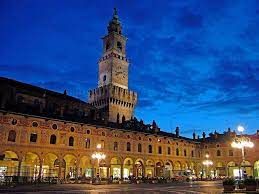
Celebrated Piazza Ducale, commissioned by Ludovico Maria Sforza a.k.a. Il Moro and it is a sort of antechamber to the the castle, it is a real masterpiece of Renaissance architecture and Vigevano’s heart and best meeting venue. The tower overlooks the square, it was built in several steps since 1198 to be completed by Bramante in the late 1400’s. You will then enter the Sforza Castle bailey, built in the first half of the XIVth century and then variously modified. The castle is made of several part all of them opening onto the main court. The three side Mastio (keep) on the right with four corner towers, was commissioned by Luchino Visconti, Vigevano Podestà, as a mansion to house and defend the visiting nobility and court from Milan. Beside the main building, abreast of the famous Loggia delle Dame (Ladies’ loggia) by Bramante, the swift columns of the Falconiera take to the three late 1400’s stables which border the bailey as far as the keep. The covered street also departs from the Mastio, it is the longest covered path in the world (164 mt) and was designed to bypass the village and quickly connect the castle with the ravelin, the Old Stronghold which opened onto the surrounding fields. Upon leaving Vigevano, head towards Pavia and reach the Sforzesca hamlet Ludovico il Moro’s 1486 hunting lodge and farm. The complex reminds of the typical castle design with four main buildings built around a nearly squared bailey and four smaller building on each corner, called colombaroni, adorned with pointed-arch windows and sawtooth friezes. All around the place a vast expanse of fields, canals and mills designed by no less than Leonardo Da Vinci who lived on the farm in the late 1400’s. The itinerary proceeds to Bozzola Abbey and then to Scaldasole nel Castello one of the main centres in the Pavia Province. It is not hard to find the real heart of the village, the pristine historic centre around which the rest of the town gradually developed. It originally was a refuge, probably dating back to the Longobard period and then reconstructed around XIIth and XIIIth centuries and later turned into the present shape by the Folperti family in the early 1800’s. The quadrilateral complex still clearly features the refuge with walkway and crenellated towers and the stronghold, presently a private mansion, which includes the old keep which once guarded the building. You will now return to San Nazzaro de Burgundi and then head back to Casei Gerola.


